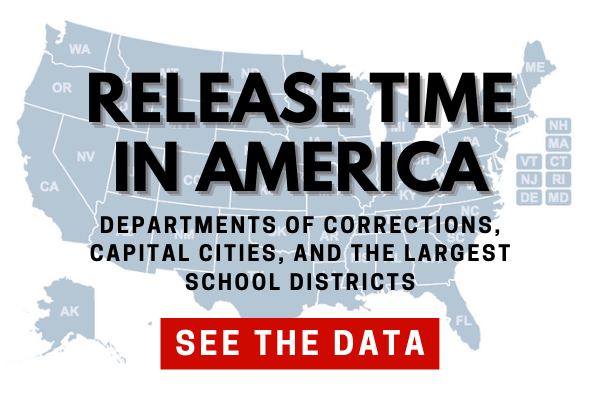Taxpayers Spend Millions to Support Private Unions. But Who Knows How Much?
October 27, 2020
Mark Flatten
National Investigative Journalist
The Goldwater Institute
Read the first report in this series, Money for Nothing.
Taxpayers across the country are spending millions of dollars to support private unions.
How much money?
None of your business.
At least that is the attitude taken by states, cities, and school districts that do not keep track of how much taxpayer time and money they are donating to public employee unions.
It is being done through the practice called union release time. Government employees who are also union officials are released from their regular duties to do union work while still drawing full pay and benefits from taxpayers.
In many jurisdictions, top union officers are on full-time release, meaning they work exclusively for the public employee unions but still draw full pay and benefits from their government employers. In others, thousands of hours are allotted annually to the unions to parcel out however and to whomever they see fit. In either case—full-time or hourly release—union representatives are allowed to leave their government duties to do union work without the loss of salary, benefits, seniority, or pension credits.
But for many jurisdictions nationwide, clearly defining how much government-paid release time is granted to the unions, and accounting for the hours and cost, is just not done.
In an effort to document release time practices nationally, the Goldwater Institute sent public records requests to the state departments of corrections, the capital cities, and the largest school districts in every state. Of the 150 jurisdictions, only 82 could give some accounting of how much release time they allowed, including 44 that reported allowing zero hours. The remaining 68 jurisdictions either could not or would not provide data on hours and costs.
Making matters worse, union contracts in many jurisdictions do not have specific language that limits the number of hours allowed for union business. Some use terms such as “reasonable,” which effectively lets union officials take an unspecified amount of time to do whatever union work they deem appropriate.
Even those contracts that do have defined caps on the number of hours often include separate language granting unlimited time for union officials to handle employee grievances, attend conferences, and negotiate new contracts.

Sometimes release time is not covered in the collective bargaining agreements at all but rather in side agreements or letters of understanding, which may or may not be disclosed publicly. In some jurisdictions, allowing union officials to do union work on the government’s time is not even considered union release, even if that is their full-time job. Rather it is viewed as unstructured time away from their regular duties, or even as part of their official responsibilities.
What it all adds up to is that in jurisdictions that fail to track union release time, there is no way for the public or policymakers to know how much is being used, how much it costs, and what it is being used for.
That’s a problem, said Christopher Moses, labor relations manager for the city of Columbus, the capital of Ohio, which does track release time. Aside from being good fiscal management, fully accounting for release time is critical to enforcing labor agreements, Moses said. Limits on release time written into contracts have no meaning if no one bothers to track it.
“The words on the page have to mean something,” Moses said. “You have to enforce it. So you’ve got to stay true to what it says, and if you blow that or you don’t track it, we would look at that as not ideal. I don’t want to say that other jurisdictions that don’t do it are wrong, but I would be uncomfortable not tracking the usage.”
Columbus was among the jurisdictions surveyed that allowed the most release time, with 38,469 reported hours at a cost of $1.1 million.

Columbus and many other jurisdictions, both big and small, meticulously track release time to the hour and penny.
It’s Only Time and Money
Tracking union release time is not particularly difficult, Moses said.
Columbus and many other jurisdictions, both big and small, meticulously track it to the hour and penny. For agencies that were able to produce complete data, finding the information usually involved a simple computer search of their payroll databases, where union release time is tracked with a unique time code.
Yet many of the nation’s largest capital cities did not provide complete data on the hours of release time they permitted. These include Boston, Denver, Sacramento, Salt Lake City, and Trenton. The largest school districts in California, Florida, Massachusetts, New York, New Jersey, and Pennsylvania did not produce data. Neither did the corrections departments in states that include Florida, Massachusetts, Missouri, and New York.
Some acknowledged they make no effort to track union release time. Others claimed they might be able to compile the data, but that it would take many hours of research.
More than Nothing
Even when a jurisdiction claims to have specific data on the hours and cost of release time, that can be misleading, even when zero hours are reported.
Jacqueline Bryant, director of communications for the Columbus City Schools district in Ohio, said in an email, “District dollars are not being used to pay for union officials. Each union pays their own official.”
However, an analysis of union contracts revealed several provisions for paid union release. Two district contracts, one for teachers and the other for non-teaching personnel, grant the unions a total of 395 days of paid union release time, which based on an eight-hour day would amount to 3,160 hours.
Bryant refused to explain the discrepancies between the contracts and her statement that no taxpayer dollars are used for union activities.
Sacramento officials used semantics to claim “departments do not permit release time” in their response to the public records request. Technically true. The contracts are with the city, not its individual departments.
Yet Sacramento’s police union is granted a bank of 5,200 hours of city-paid release time to use as it sees fit, and the fire union is allotted 4,000 hours. When hours allowed to a third union are included, the total for California’s capital city amounts to almost 14,000 defined hours of release time.
The records request sought all city-paid hours and costs associated with release time, broken down by individual departments.

In Denver, taxpayers are in the dark. The city could not provide data on the hours and cost of release time granted to its unions.
Clearly Vague
Another problem in figuring out how much release time a jurisdiction allows is that many contracts have no defined limits. Again, that means that unless the time is tracked, there is no way to know how much was taken.
Denver could not provide data on the hours and cost of release time granted to its unions. The city’s union contracts are particularly vexing when it comes to estimating release time because of open-ended language, and side letters granting extensive paid leave to perform union duties.
The Denver police and fire contracts include similar language stating top officers in each union shall be granted fully paid leave from duty “for conducting necessary union business.” They do not place any limit on the number of hours or even specify what union business the time can be used for.
City officials say this is not full-time release. Rather, union officials for the two departments may be released periodically on an as-needed basis to attend to union business, but they are still normally assigned to their regular shifts and duties.
Aside from the contracts themselves, the police and fire departments also have side letters with their unions granting extensive release time.
The Denver Police Protective Association reached a side agreement in February 2019 releasing its seven executive board members from their regular duties to attend a variety of union meetings, some running four hours each week. Those provisions add up to about 2,136 hours of release time, depending on whether all board members are on duty when they occur.
City officials said they do not consider this paid union time either, but rather excused time from their regularly assigned duties.
In July 2018, the Denver firefighters’ union signed a side agreement with the city granting the top two union officials full-time paid release through the end of the year. It includes a line that the agreement could be renewed, or not, every year thereafter. The city did not provide additional information as to whether that side agreement was subsequently renewed.
‘Reasonable Release’
Salt Lake City is another jurisdiction that does not track release time. Its contracts with police and fire unions are riddled with vague language that allows top union officials “a reasonable period during working hours” to attend to union business, without defining what that means. Other provisions in various agreements allow approximately 5,600 defined hours for union release.
Beyond the ill-defined “reasonable” language, Salt Lake City’s contracts illustrate how even seemingly innocuous provisions can add up to big blocks of paid release hours because of the number of people involved.
In the city’s agreement with AFSCME Local 1004 is language allowing up to 33 stewards to each take 76 hours annually to conduct union business. That totals more than 2,500 hours per year for those 33 stewards.
There are similar provisions for union board members and the president, raising the total to more than 3,400 hours per year.
And that’s just from one Salt Lake City union contract. It does not count agreements with police and fire unions, both of which have their own “reasonable” release provisions.
Rachel Otto, chief of staff in the Salt Lake City mayor’s office, acknowledged there is too much ambiguity in the city’s labor contracts when it comes to release time, and the city should be doing a better job of tracking the hours and cost. It is a situation that the new mayor inherited when she took office in January 2020, and a topic that has been discussed internally, Otto said.
“You’ve raised questions that we’ve had ourselves about why we don’t track it,” Otto said. “I think a lot of it is that these contracts just get baked over so many years that stuff just gets in there, and it’s hard to get out.”
Even jurisdictions that have no union contracts can still give release time to union officials without publicly accounting for it. The Fairfax County, Virginia, school district did not have a union contract last fiscal year, and did not provide data on release time. However, buried deep in the district’s personnel policies is a provision allowing the district to grant paid union leave to employees for “activities related to performing the representational duties of the employee organizations.” There is no cap on the hours, only the constraint that the number of days “shall be limited by budget constraints and other appropriate factors.”
Costly Hob-nobbing
Other areas in which an undefined number of hours can translate to big blocks of undisclosed release time are conferences and negotiations.
In Providence, Rhode Island, the contract with its fire union allows release time for up to 10 union officials to attend all local union meetings; six of them to attend the separate conventions of the International Association of Fire Fighters, the AFL-CIO, and the Rhode Island Association of Fire Fighters; and two to attend “any other conventions, conferences and seminars.”
Providence did not disclose its hours and costs, so there is no way to determine how many hours that conference provision amounts to.
The Montgomery County, Maryland, School District’s contract with its teachers union grants up to 250 days of leave for association members to attend the Maryland State Education Association’s annual convention. That’s about 2,000 hours, based on an eight-hour day. The district did not produce data on release time.
Teachers association days are sometimes used by unions to turn their members out in force to lobby legislatures or school boards for union priorities, such as more pay, more benefits, or to protect release time.
Paid release time for contract negotiations can also be a big-ticket item that goes unreported because of the number of people involved. Most contracts do not set any limit on the number of hours allowed for negotiations. Many do not restrict the number of union representatives who can be released to participate.
That can add up quickly.
For example, employees in the Los Angeles Unified School District are represented by eight different unions, each of which is allowed a certain number of officials to be released with pay for negotiations, regardless of how long they take. All totaled, that allows at least 45 union representatives unlimited amounts of release time for negotiations.
A few jurisdictions do cap total hours allowed for negotiations, which gives some idea of what they consider a reasonable amount of time. For instance, the Columbus, Ohio, contract with the Fraternal Order of Police allots 4,000 hours for negotiations, and thereafter whatever “reasonable” time is required.
Moses, the labor relations manager in Columbus, said city administrators have tried to rein in open-ended release time provisions in its union contracts.
The idea is not to end or even cut back on release time, which city officials see as beneficial, Moses said. Rather, it is to set more defined limits on hours and what paid release time can be used for.
The unions resisted any changes, and so far they’ve been successful.
“It’s not a third rail for us,” Moses said. “We want to make sure people are at their jobs, they’re not abusing it, they’re using it for the right reasons. It’s sort of an accountability factor. We could absolutely tighten it up, but I think the unions would, as they’ve done in the past, be very resistant to it. It’s something they pride themselves in. It’s something they can use for their benefit.”
Note: The Goldwater Institute filed a lawsuit in 2019 challenging the practice of release time in the City of Phoenix. That suit is pending.
Get Connected to Goldwater
Sign up for the latest news, event updates, and more.
Recommended Blogs

Donate Now
Help all Americans live freer, happier lives. Join the Goldwater Institute as we defend and strengthen freedom in all 50 states.
Donate NowSince 1988, the Goldwater Institute has been in the liberty business — defending and promoting freedom, and achieving more than 400 victories in all 50 states. Donate today to help support our mission.

We Protect Your Rights
Our attorneys defend individual rights and protect those who cannot protect themselves.
Need Help? Submit a case.


